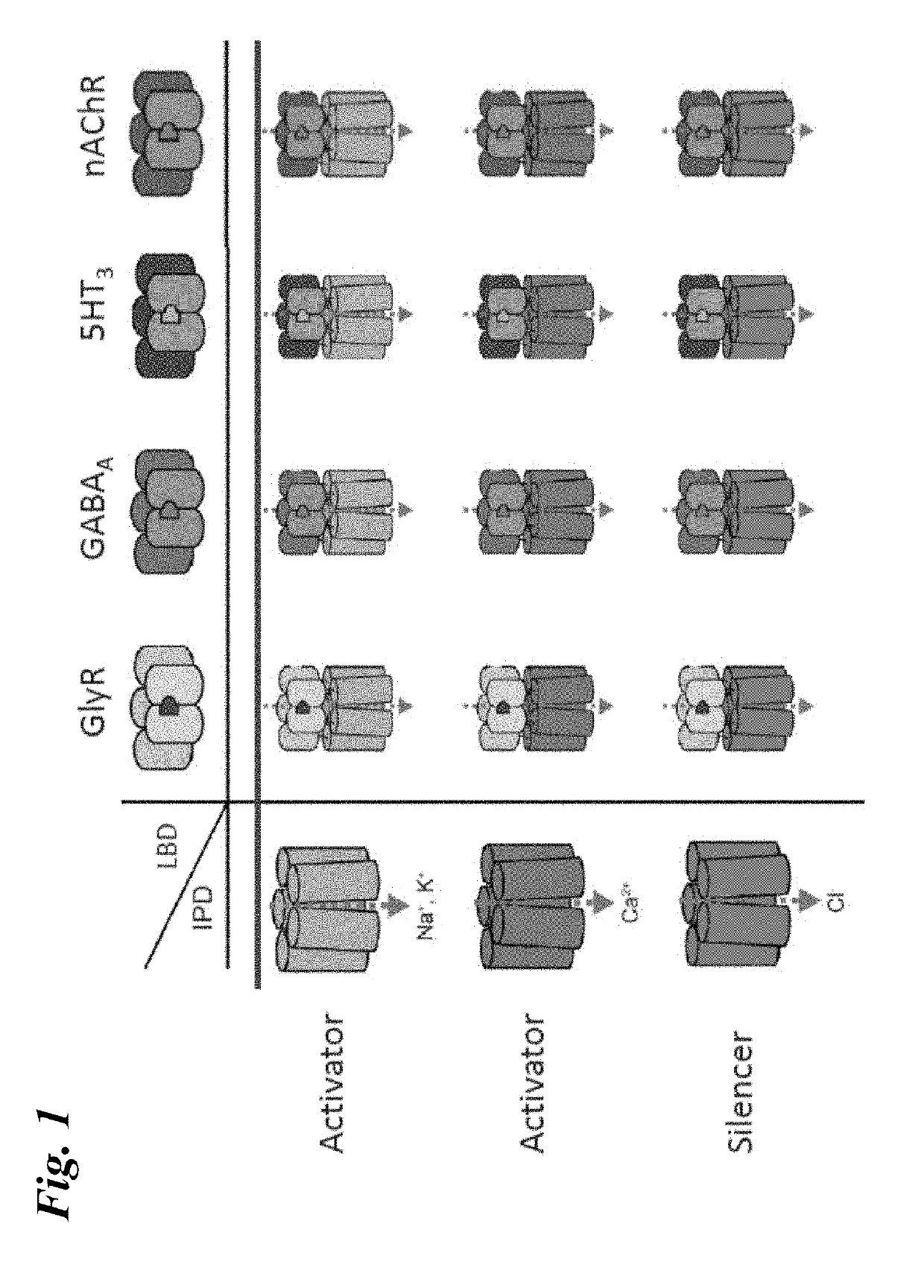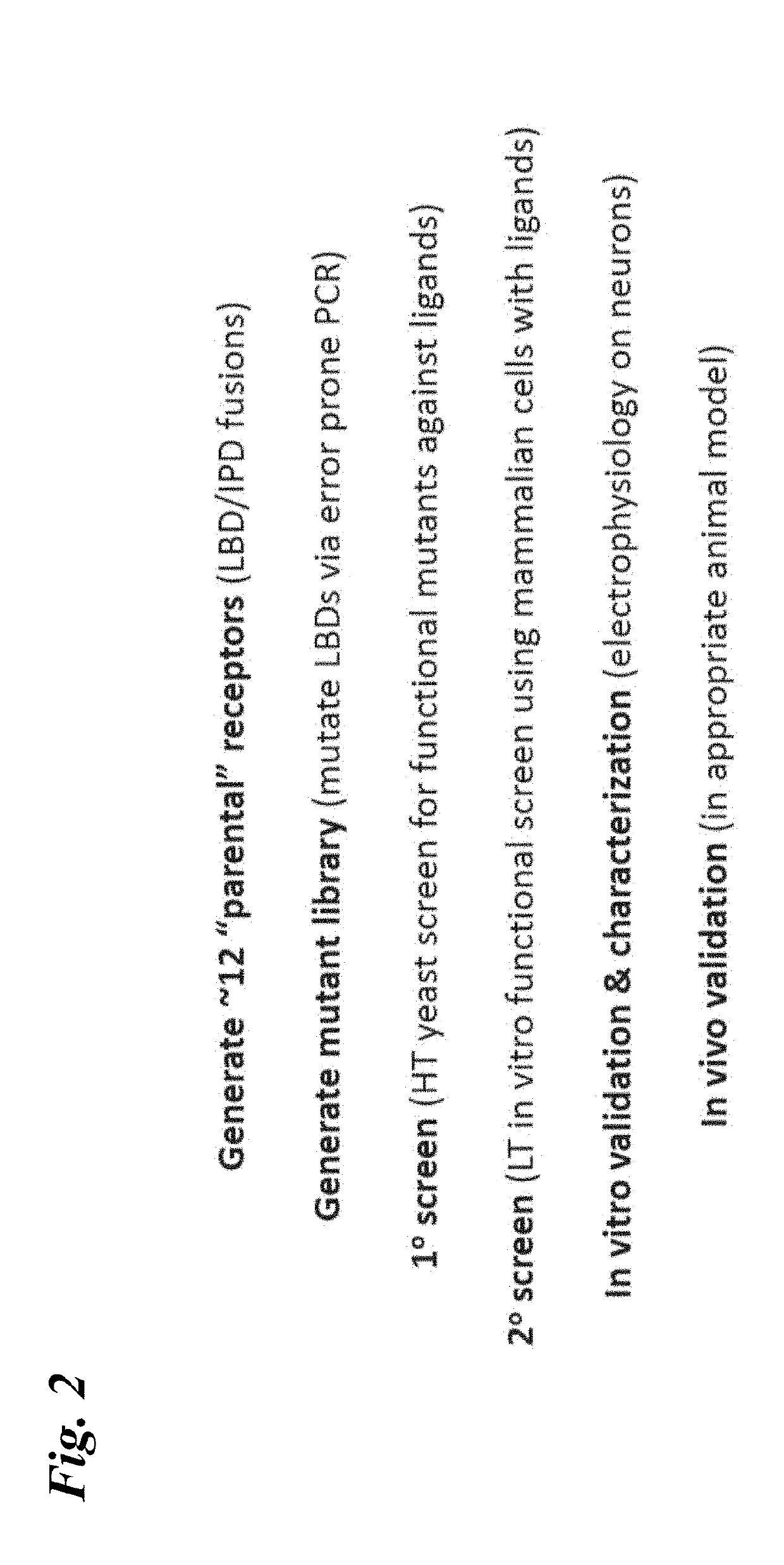Compositions and methods for neurological diseases
a technology for neurological diseases and compositions, applied in the field of engineering receptors, can solve the problems of affecting the development of therapies for treating these conditions, affecting the development of therapies, and affecting the quality of life of patients, and achieves the effect of increasing the binding affinity of a binding agent and reducing the binding affinity of endogenous ligands
- Summary
- Abstract
- Description
- Claims
- Application Information
AI Technical Summary
Benefits of technology
Problems solved by technology
Method used
Image
Examples
example 1
and Characterization of Engineered Receptors
[0241]Chimeric LGIC receptors comprising the ligand binding domain from the α7-nAChR and the chloride-conducting ion pore domain from the human GlyR1α were engineered and assessed for their responsiveness to acetylcholine, nicotine, and several small molecule agonist ligands. Amino acid substitutions were then generated in these “parental” chimeric receptors and the mutants retested for responsiveness to these ligands.
[0242]Differences in potency (EC50) and current flow (Imax) were observed, both among the engineered chimeric receptors and between the chimeric receptors and the wild type α7-nAChR, suggesting that the domains that contribute to the extracellular domain of the engineered receptor play an influential role in channel properties. Amino acid substitutions in these engineered channels further altered the responsiveness of the channel, in some cases differentially for different ligands. These results indicate that a toolbox of LGI...
example 2
the Efficacy of Engineered Receptors to Treat Disease in Animal Models
[0257]Chimeric LGIC receptors comprising the ligand binding domain from the α7-nAChR and the chloride-conducting ion pore domain from the human GlyRα1 subunit are assessed for their efficacy in providing analgesia in an rat model of neuropathic pain following administration of a small molecule ligand.
Materials and Methods
[0258]AAV Vector Production:
[0259]Eight expression cassettes are constructed using standard molecular biology techniques. All contain a human synapsin-1 (hSYN) promoter linked to engineered chimeric receptors comprising a ligand binding domain of α7-nAChR and a Cys-loop domain and ion pore domain of GlyRα1. Their design is as follows:
[0260](a) Chimera 1: no additional changes.
[0261](b) Chimera 2: similar to 1, but also comprises an amino acids substitution from FIG. 8H that renders the engineered receptor less responsive to acetylcholine than either the wild type receptor or parental chimeric rece...
example 3
of a Patient Suffering From Chronic Pain
[0279]In a non-limiting example, a patient suffering from chronic radicular pain is treated using the compositions and methods disclosed herein. The patient is treated on Day One with 1013 vector genomes of AAV.hSYN-α7-nAChR / GlyRα1 in a volume of 1.0 mL delivered directly into one or more dorsal root ganglia (i.e., intraganglionic convection-enhanced delivery into lumbar, cervical, or thoracic DRGs). In this example, the AAV vector encodes the α7-nAChR / GlyRα1 chimera under the control of the human Synapsin-1 (SYN1) promoter for selective neuronal expression. Two weeks post-injection, the patient returns to the clinic for a prescription for AZD-0328. The patient self-administers 0.1 mg / kg AZD-0328 orally as needed (i.e., during a pain episode).
PUM
| Property | Measurement | Unit |
|---|---|---|
| Tm | aaaaa | aaaaa |
| volume | aaaaa | aaaaa |
| volume | aaaaa | aaaaa |
Abstract
Description
Claims
Application Information
 Login to View More
Login to View More - R&D
- Intellectual Property
- Life Sciences
- Materials
- Tech Scout
- Unparalleled Data Quality
- Higher Quality Content
- 60% Fewer Hallucinations
Browse by: Latest US Patents, China's latest patents, Technical Efficacy Thesaurus, Application Domain, Technology Topic, Popular Technical Reports.
© 2025 PatSnap. All rights reserved.Legal|Privacy policy|Modern Slavery Act Transparency Statement|Sitemap|About US| Contact US: help@patsnap.com



